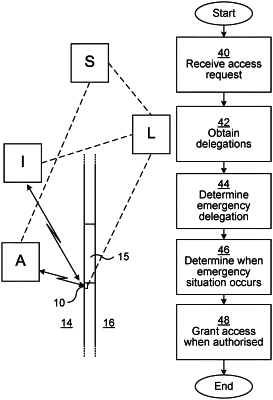| CPC G07C 9/38 (2020.01) [G07C 9/00571 (2013.01); H04L 9/0825 (2013.01); H04W 4/90 (2018.02); G07C 2009/00769 (2013.01); G07C 2209/04 (2013.01)] | 18 Claims |

|
1. A method for controlling access to a physical space using an emergency delegation, the method being performed in a lock device and comprising:
receiving an access request from an electronic key;
obtaining a plurality of delegations, wherein each delegation is a delegation from a delegator to a delegatee, the plurality of delegations collectively forming a chain of delegations wherein when two delegations are chained together, the delegatee of one delegation is the delegator of the next delegation;
determining that a delegation in the chain of delegations is an emergency delegation, the emergency delegation indicating that access should only be granted when an emergency situation occurs, wherein one or more types of emergency situation are specified in the emergency delegation; and
granting access to the physical space in response to both (i) determining that the chain of delegations starts in the lock device ends in the electronic key and (ii) determining that the emergency situation occurs.
|